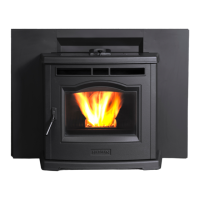Harman® • P42i Pellet Insert Installation Manual • 2023 -___ • 08/2318 8742-901D
G. Negative Pressure
WARNING! Risk of Asphyxiation! Negative pressure can
cause spillage of combustion fumes and soot.
Negative pressure results from the imbalance of air available
fortheappliancetooperateproperly.Itcanbestrongestin
lower levels of the house.
Causesinclude:
• Exhaustfans(kitchen,bath,etc.)
• Rangehoods
• Combustion air requirements for furnaces, water heaters
and other combustion appliances
• Clothes dryers
• Locationofreturn-airventstofurnaceorairconditioning
• ImbalancesoftheHVACairhandlingsystem
• Upperlevelairleakssuchas:
- Recessedlighting
- Attichatch
- Ductleaks
Tominimizetheeectsofnegativeairpressure:
• Installtheoutsideairkitwiththeintakefacingprevailing
winds during the heating season
• Ensure adequate outdoor air for all combustion appliances
andexhaustequipment
• Ensure furnace and air conditioning return vents are not
located in the immediate vicinity of the appliance
• Avoid installing the appliance near doors, walkways or
small isolated spaces
• Recessedlightingshouldbea“sealedcan”design
• Attic hatches weather stripped or sealed
• Attic mounted duct work and air handler joints and seams
taped or sealed
NOTICE: Hearth & Home Technologies assumes no
responsibility for the improper performance of the chimney
system caused by:
• Inadequate draft due to environmental conditions
• Down drafts
• Tight sealing construction of the structure
• Mechanical exhausting devices
H. Avoiding Smoke and Odors
Avoiding Smoke and Odors
Negative Pressure, Shut-down, and Power Failure:
To reduce the probability of back-drafting or burn-back in
the pellet burning appliance during power failure or shut-
down conditions, the stove must be able to draft naturally
withoutexhaustbloweroperation.Negativepressureinthe
house will resist this natural draft if not accounted for in the
pellet appliance installation.
Heatrisesinthehouseandleaksoutatupperlevels.This
airmustbereplacedwithcoldairfromoutdoors,whichows
into lower levels of the house. Vents and chimneys into
basements and lower levels of the house can become the
conduit for air supply, and reverse under these conditions.
Outside Air:
Hearth & Home Technologies recommend attaching
outside air in all installations, especially lower level and
main oor locations.
Per national building codes, consideration must be given to
combustion air supply to all combustion appliances. Failure
to supply adequate combustion air for all appliance demands,
mayleadtoback-draftingofthoseandotherappliances.
Whentheapplianceisside-wallvented:Theairintakeisbest
locatedonthesameexteriorwallastheexhaustventoutlet
andlocatedloweronthewallthantheexhaustventoutlet.
When the applianceis roof vented:Theair intake is best
locatedontheexteriorwallorientedtowardstheprevailing
wind direction during the heating season.
The outside air connection will supply the demands of the
pellet appliance, but consideration must be given to the
totalhousedemand.Housedemandmayconsumesome
airneededforthestove,especiallyduringapowerfailure.It
may be necessary to add additional ventilation to the space in
which the pellet appliance is located. Consult with your local
HVACprofessionaltodeterminetheventilationdemandsfor
your house.

